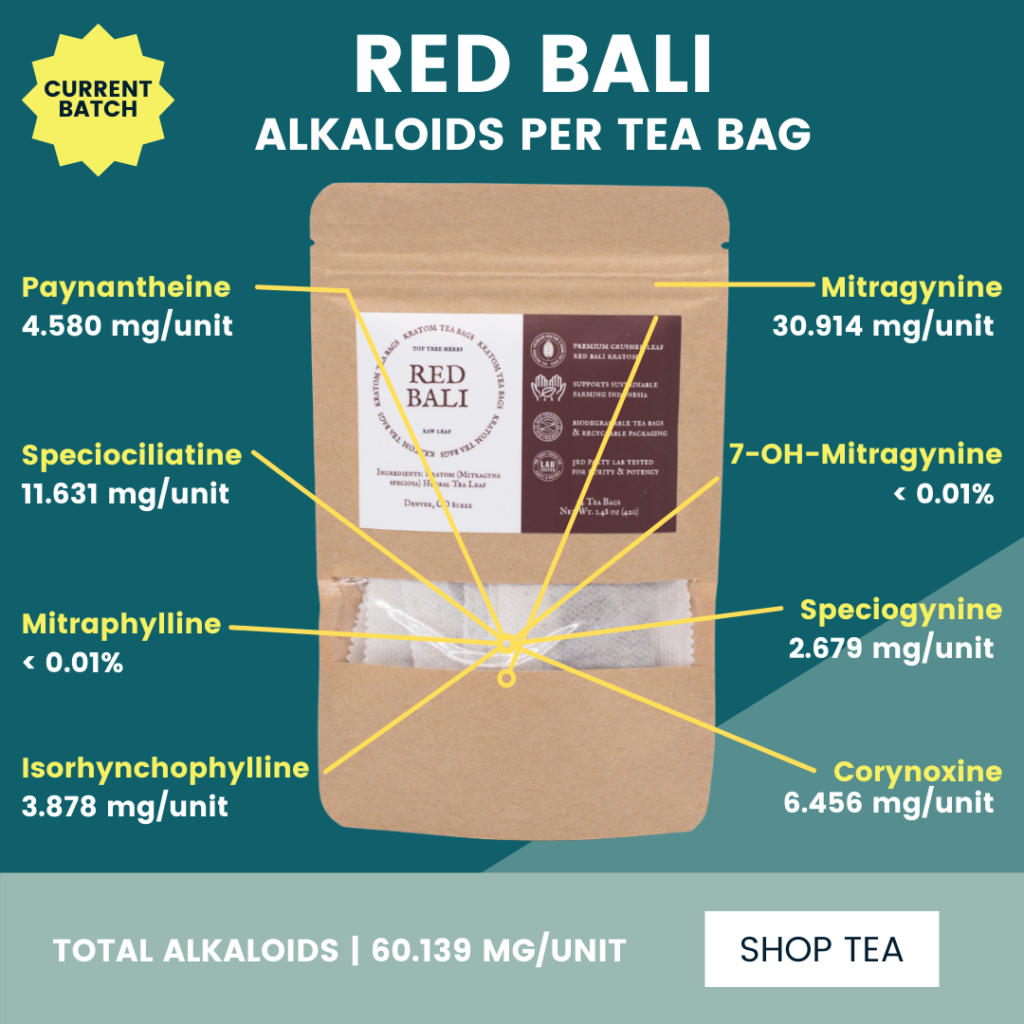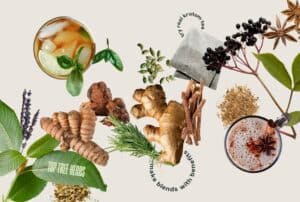Introduction
If you’re new around here, you probably have kratom tea questions. And you should! Even some of the most experienced kratom consumers in the US haven’t tried kratom tea yet. Some don’t even know that’s how this wonderful plant has been used for hundreds of years.
And this isn’t a value judgement – it’s an experience that connects all US kratom consumers. We’re living in the wake of the US war on drugs, which means there are about three generations between what we learned in school and the truth.
All of this is to say there are a lot of unanswered questions when it comes to kratom tea. To play our role as tea educator and normalizer, we put together the top 10 questions about kratom tea.
The first five are specific to our customers – we cover the questions we get most often. It’s relevant to any kratom tea drinker, but the pro-tips will only make sense if you’re a seasoned Top Tree brewer.
Frequently Asked Kratom Tea Questions
#1 How Do I Make Kratom Tea?
We absolutely love being asked how to make kratom tea! While brewing kratom tea is easy enough, it does require following a basic formula.
Because there is such a distinct difference between a properly brewed kratom tea and an incorrectly brewed one, we believe it is worth spending extra time and energy redundantly educating our community on how to make kratom tea.
First off, you do NOT make kratom tea the same way you would make a typical black or green tea (from the plant Camellia sinensis). Teas brewed from the leaves of C. sinensis contain caffeine, and as such need only a few minutes steeped in hot water.
Steeping these tea leaves longer than 5 minutes or using water that is too hot can result in an unpleasantly bitter beverage that can upset your stomach.
Kratom tea is quite different. To correctly brew kratom tea you need to forget the above important considerations for brewing C. sinensis tea. The water should be near boiling and the steep should reach or exceed 20 minutes.
The reasons behind these differences are the chemical properties of the molecules in the respective leaves. Caffeine dissolves into water much more readily than do the alkaloids in kratom, also known as the mitragynines. (If you have any questions about kratom alkaloids, stick around for question #6!)
Kratom Tea Steps
- Place tea bags into thermos
- Squeeze half a lemon (or another acidic addition)
- Pour boiling water into the thermos and cap immediately
- Let steep for 20 minutes
- Cool and enjoy
Kratom Tea Thermos
Since the kratom alkaloids are harder to get out of the leaf and into the water, also known as “water insoluble,” we have to use pressure, heat, and time to move the odds into our favor. To increase solubility, you can increase the temperature or pressure or both. A thermos optimizes the brew by touching on both.
When you pour boiling water into a vacuum sealed thermos you are starting with the maximum temperature of water. Depending on how good your thermos is, when you uncap it in 20 minutes it will still be near boiling temperature. Simultaneously, the boiling water creates slight positive pressure inside your capped thermos.
Thirdly, a twenty minute steep. When you combine the thermos and lemon brewing techniques, you will spend a little over 25 minutes brewing your tea. From cutting your lemon and boiling your water, preparation is quite short, and even shorter yet if you use bottle lemon juice. Comparatively, the traditional Thai kratom tea is simmered for upwards of three hours!
Kratom Tea Kettle
If you don’t have a thermos, you’re not out of luck. As just mentioned, Traditional Thai kratom teas were simmered for hours on end. By utilizing an acid like lemon juice or apple cider vinegar we are able to increase the solubility of the kratom alkaloids and shorten the necessary steep time. The traditional method is great for those who either don’t have an acidic additive on hand or who just prefer the flavor “black”.
We usually prepare our kratom in a tea kettle when we’re serving groups. First we through in about 10 bags into a pot or tea kettle and add the juice of a lemon or two. We then fill it up with some filtered water and bring to a nice boil. Once boiling, reduce to a simmer and wait 20 minutes before removing. You will usually see a reduction of about 1/6th of your water. This can be served hot or, since it is so strong, mixed with ice water or, our favorite, some lemonade.
Kratom Tea
There are several different ways of brewing kratom tea. Most still result in a gritty, sandy cup of kratom tea. These incomplete but workable brewing preparations include the french press method, the macha-esque slurry, and using coffee filters. The issue with all of these methods is that most people use micronized kratom powder. These small particles are good for shipping kratom, putting it into capsules, and homogenizing the alkaloids in leaves from varying trees.
However, whenever it comes down to the consumer experience, i.e. the taste of the tea, micronized kratom powder is not the move.
Brewing Kratom Tea with Micronized Powder
Still, if you are stuck in a situation where you only have powder and you want some tea, here’s how we recommend you do it. First, boil a mixture of your kratom powder and a splash of lemon juice. Bring to a rolling boil, reduce to a simmer, and keep on heat for 20 minutes. Then, pour your gritty mixture into a french press. Before inserting the strainer of the french press into the vessel, drape a coffee filter over it for more straining.
Finally, gently press down on the french press to strain it. The mixture will still be gritty, but at this point you will have removed most of the powder. You can continue to filter it using coffee filters and funnels, but at this point the amount of work necessary to make it smooth is not worth the effort.
Brewing with Tea Bags
Tea bags, on the other hand, require little attention during the brew process and are perfectly smooth every step of the process. As the first kratom tea bag company, we set out to fix the problems associated with brewing kratom tea. To do this, we changed the type of kratom we use in our product. Instead of micronized powder, we use premium, crushed leaf kratom. Since their particle size is much larger than the powder, they stay within the tea bag, and only impart their strength and taste to the hot water, not their texture.
To brew kratom tea from tea bags, simply follow these steps.
- Put tea bags into a thermos
- Add an acid (lemon juice, lime juice, citrus fruit, apple cider vinegar, etc.)
- Add boiling water
- Cap thermos and steep for 20 minutes
- Cool, sweeten to taste, and enjoy!
Why Should I Use an Acid?
If you’re a new to kratom tea, chances are you don’t know what purpose the “acid” serves. Why do we keep recommending it? For a complete breakdown of the chemistry, check out our earlier blog post on the subject of kratom chemistry. In short, it all goes back to the hydrophobic trait of kratom alkaloids.
To make these alkaloids want to dissolve in water more, we can do a number of things. As discussed, increasing temperature and pressure helps immensely. Adding an acid, like the citric acid found in lemon juice, makes the alkaloids more water soluble. In essence, the acid binds with the kratom alkaloids, lowering their energy, and encouraging them to dissolve in the hot water.
Now the acid is not absolutely necessary, simply using hot water and/or high pressure will also yield a strong tea. However, omitting the acid dramatically increases the time needed to make a powerful beverage. Traditionally, in Thailand kratom tea leaves were simmered for upwards of three hours (without any acidic additives)!
#2 Is Kratom Tea Stronger than Powder?
When it comes to kratom, strength is key. Especially since there haven’t been many kratom brands focused on flavor (until now), the only reason people used kratom was for the effects. Within this context, taking more of a weaker kratom type simply meant bearing more of the unpleasant taste. Despite how delicious kratom tea can be, you may still base your decision on strength alone. If that sounds like you, you’re in luck — the delicious tea option can be just as strong as kratom powder!
The secret to making a strong cup of kratom tea is brewing it correctly. To do so, simply review the previous question in this post. Kratom tea can be weaker than powder, but only if you brew it incorrectly. Ultimately, gram for gram, kratom tea can deliver the same amount of kratom alkaloids to your bloodstream as swallowing powder. However, kratom tea has a build in safety-net. Tea requires a long brew in the correct conditions to extract all of the alkaloids that make it as strong as simply swallowing the powder.
Pro-tip: Double brew your tea bags! We can’t stress this enough: if you want to get the most of each tea bag, brew them twice! And if you’re using more than 2 tea bags, we say go for a third brew before replacing your tea bags. The tea will get weaker (in flavor and effect) each time you brew, so don’t forget to account for that.
#3 How Much Kratom to Take?
Kratom stands apart from pretty much everything else in its opposing effects at different serving sizes. At small serving sizes kratom tea is energizing and uplifting. It is great for tasks that require focus and increased engagement. That’s why we are such strong proponents of replacing coffee and caffeine containing teas with kratom tea!
Some days we completely cut caffeine from our routine and get our morning and mid-afternoon jolt of energy from kratom. Other days, we still kick off our day with caffeine, but as the afternoon comes we use kratom tea instead of coffee to give us our second wind. This is because we find it much easier to fall asleep after using kratom tea its energizing effects later in the day than we do with caffeine.
A Few Servings
As stated, kratom tea has opposing effects at different serving sizes. As you ramp up your serving size to, say, 3 or more tea bags depending on the person, you’ll find that you no longer get an energizing effect. Instead, the effects will be focused on the body and promote and overall sense of wellbeing and relaxation. We love using these larger kratom tea serving sizes as a sleepytime tea!
Aside from the dramatically better flavor of kratom tea, it has other advantages over straight powder. In the most comprehensive kratom survey to date, Dr. Oliver Grundman uncovered that over 20% of kratom consumers have kratom related stomach issues. By and large, this is unsurprising given that swallowing kratom leaves has never really caught on in the multi-century traditional use of kratom.
Kratom leaves are largely composed of insoluble fiber. This means that it passes through our digestive tract unchanged for the most part. If you swallow heaping piles of powder, you should be prepared for your stomach to voice a few complaints. SInce tea can deliver the same amount of kratom alkaloids as powder, it succeeds in cutting out the stomach distressing variable. The indigestible leaf matter.
#4 How Do I Make Kratom Tea Stronger?
Stronger Strains
There is nothing quite like a strong cup of kratom tea. Yet if you are struggling to get your kratom tea as strong as you’d like, try some of these troubleshooting options to bring back the punch! First, alternate your kratom strain. Not all kratom trees have the same amount of alkaloids in them. That means that every “strain” is different. (Check out our two part post on the myth of the kratom strain.)
Unfortunately, the lack of a meaningful classification system rules out the ability to generalize about strains across batches. Luckily, Top Tree Herbs has state of the line, eight panel alkaloid data sheets for each tea strain and batch. Therefore, we can say with confidence which of our strains has more alkaloids. At the moment, our strongest teas are our reds, followed by our whites, and with our greens tailing behind. (However, our greens happen to have the most speciogynine.)
Using Extra Tea Bags
A simple way to up the strength of your tea is to add another tea bag to your thermos! Just remember, if you’re aiming for the energizing effects, adding too many tea bags could push you into the range of relaxation instead. This simple fact is why we always suggest that new kratom tea drinkers start off with one or two tea bags before gradually testing more tea bags over time.
Using Lemon or Lime Juice
We discussed the “why” behind adding an acid into your tea improved the potency in question #1. If you are struggling with making your kratom tea stronger, you should definitely make sure you are using an acid, brewing in a thermos, and using boiling water.
Longer Brew Times
For starters, you should always steep your kratom tea for at least 20 minutes. Still, 20 minutes is not enough to get all of the alkaloids out of the kratom and into the tea. This is why we always recommend starting your second brew as soon as you finish your first, to get the last of the good stuff out! Another strategy we have for getting more of the alkaloids out on the first try is to brew our morning kratom tea at night, and let it steep while we sleep! The long steep time makes a tea that is considerably stronger than one made in 20 minutes!
#5 How Long Do I Wait Before Making More Kratom Tea?
How much and how frequently you take kratom is entirely up to you. But to make the right decision for you, you need to be educated. For starters, kratom tolerance is very real. Just like coffee, if regularly consumed, the amount of kratom tea necessary to produce the effects you are aiming for will slowly increase. Of course, you can simply refrain from drinking kratom tea for a few days to reset your tolerance.
The way people use kratom tea varies, and is largely unknown. This is why Top Tree has partnered with Dr. Oliver Grundman, Santé Labs, Hamilton Morris, and our kratom tea community to run the most comprehensive kratom tea survey to date. With your help, we’ll be able to collect a significant amount of responses and correlate people’s subjective effects with the objective alkaloid data to better understand why people drink kratom tea!
However, until this data is released, we only have a few anecdotes and tradition to guide us. Importantly, farmers used kratom all day every day in Thailand while they were working. They take very small serving sizes (a couple of sips of a chewed leaf) periodically throughout the day. In the US, many consumers only use it in the morning, and other only use it at night. For some it’s a preworkout, and for others it helps them recover. Just like it’s cousin coffee, everyone has a reason, amount, and frequency that’s right for them. For all intents and purposes, you can expect the effects to come and go within 4-6 hours.
#6 What Does Kratom Tea Taste Like?
.Kratom has a very unique palette of flavors. For many, the first taste is unpleasant. But like wine, coffees, and teas before it, you cannot pass judgement until you have a second taste after acclimating yourself. Initially, the bitter rush is all that people can distinguish, but the following tastes reveal a vast profile of both subtle and intense flavors. Again, like coffee, kratom has a range of flavors – from the strong, intense flavor of espresso to the sickly sweet iced flavored lattes, kratom has a counterpart for every variety.
If you do not like kratom “black,” as in, not sweetened or flavored, that’s okay! It is definitely an acquired taste. We recommend you try one of our unique, specialty kratom herbal blend teas or one of our naturally flavored kratom teas! There are morning, afternoon, and evening blend kratom fortified with complementary and synergistic traditional herbs! We also have flavored kratom using the natural essential oils of its particular flavor. Like lemon lime, strawberry, peach, and during the holidays, pumpkin spice!
#7 What are Kratom Alkaloids?
One of the more complicated, but helpful areas of kratom to familiarize yourself with are the alkaloids. At a basic, chemistry level definition, an alkaloid is a molecule found in a plant (phytomolecule) that has a base nitrogen in its structure. Usually, this free nitrogen makes it a central nervous system stimulant, as they readily bind with receptors in our body. Caffeine is probably the most well known alkaloid, and most used. While alkaloids are not the only phytomolecules that have beneficial activity in our body, for a long while this was what many plant scientists searched for since so many of them have activity in humans.
Mitragynine
Mitragynine is the most abundant alkaloid in kratom. For this reason, it is also the most studied alkaloid. Initially, it was believed that it’s main function derived from it’s partial activity at the same receptors that endorphin targeted, the mu-opioid system. However, new studies are beginning to shed light on the complex pharmacodynamics of mitragynine and related alkaloids.
Just recently in September 2021 a paper was released detailing how a close analogue of mitragynine, SC13 has very similar effects without hardly any action at the opioid receptors. Likewise, Dr. McCurdy’s lab has confirmed kratom’s serotonergic effects as well. (This is unsurprising giving it’s structural resemblance to other indole, serotonergic compounds like serotonine itself as well as psilocybin and ibogaine.)
40-Plus Kratom Alkaloids
While many kratom alkaloids have been discovered, their exact mechanism and effect remain largely unknown. A complete overview of what we know about each alkaloid is a topic for another post. We’ll leave the topic with a simple list of the alkaloids we’re paying the most attention to (and therefore testing for)!
- 7-OH-Mitragynine
- Paynantheine
- Speciogynine
- Speciociliatine
- Mitraphylline
- Isorhynchophylline
- Corynoxine
#8 Kratom Tea vs. Pill: Pros & Cons
While we’re certainly biased in the direction of kratom tea (think traditionally aligned, cleaner, safer, and tastier; it’s a no brainer!) there are other ways to take kratom. Tea, however, is the only taste positive options. Unfortunately, we can’t recommend any of the taste-negative options (like toss and wash) simply because if it makes us gag, we don’t want to recommend you take it. And by taking kratom powder off of the table, we’re left with kratom capsules.
Kratom Capsules
In the taste department, kratom capsules are completely neutral. Simply put, they are vegetable cellulose capsules filled with kratom powder. Of course, you end up swallow the kratom powder, and not just the alkaloids like you would in a tea. If you’re sensitive to stomach aches, this option may not be right for you. However, many are able to get by without any real stomach problems if kratom capsules are taken at small serving sizes and not regularly so as to give your body enough time to process the insoluble fiber.
The only situation where kratom capsules are preferred over kratom tea ware situations where brewing the tea are difficult to impossible. We’ve been in situations like this when traveling or going through the airport. And of course, kratom capsules are great for determining the right serving size, even if you empty the capsules into juice, as many people use them. If you look at our capsule labels (coming soon!), for example, you’ll notice a graphic on the front that shows how this is done.
Ultimately, even know we’re kratom tea bag people, we understand the value of having a few different kratom tea options on hand.
#9 Is Kratom Legal?
Yes, full stop. There has been no federal action regarding the legality of kratom. In the US, kratom is legal everywhere that has not made explicit laws banning it. Those states are Alabama, Arkansas, Illinois, Indiana, Louisiana, Tennessee (for under 21), Vermont, Wisconsin, and the District of Columbia. Notable, it is also banned in Sarasota Co, Fl, and in San Diego.
Kratom is illegal in these areas because they accepted lies and misinformation as truth. A great review of the legality issues can be found in Jane Babins paper “FDA Fails to Follow the Science on Kratom.”
#10 How Long Does Kratom Last?
When it comes to kratom shelf-life, the general rule is the fresher the better. That said, kratom will last a long time if stored correctly. You want to keep it out of the light, in a sealed container, away from any moisture. If you follow these best practices, your kratom will last for about a year.
When your kratom is older than a year, it normally doesn’t taste as good when brewed into a tea, and there’s a good chance it’s lost some strength as well. We’re planning on conducting a shelf-life study in the coming months so we have a more scientific answer to this question, but we hope this helps for now!
Conclusion
We’ve been teaching people how to brew kratom tea for a long time now, and we’re always surprised about how many misconceptions are out there about the process. Today we hope we answered some of your questions about making kratom and enjoying kratom tea.
As you’ll see, making kratom tea is all about being open to experimenting. It’s about finding out what works for you – striking a balance between taste and effect. We’ve learned that people use kratom tea for a variety of different reasons, so you should always make sure to contextualize any instructions you find online.







